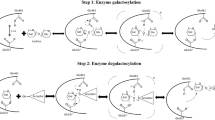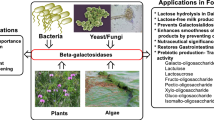Abstract
Moutai Jiuqu is a famous aromatic raw material of Maotai flavor liquor in China. It is brewed at high temperature and contains many kinds of bacteria, molds, and yeasts. There are many useful glycoside hydrolases in these microfloras, from which efficient glycoside hydrolases can be screened for biotransformation of natural saponins. In this study, an α-L-arabinofuranosidase gene (CaAraf51, 1524 bp, 507 amino acid, 55.07 kDa, and pI = 4.8) was cloned from Cellulosimicrobium aquatile Lyp51, which was isolated from the Maotai Jiuqu. The CaAraf51 was heterogeneously expressed in E. coli BL21 (DE3) and purified by N-terminal His-tag with the Ni2+-affinity column chromatography. The results show that purified CaAraf51 has a 6.8-fold purification factor and specific activity of 15 U/mg. Under optimal conditions (pH 5.0, temperature 40 °C), kinetic parameters Km of CaAraf51 for pNPαAraf and Rc were 1.1 and 0.57 mM, the Vmax were 25 and 6.25 μmol/min/mg, respectively. 90% of 0.87 mg Rc substrate can be transformed by 9.6 U purified CaAraf51 in 1 mL reaction system under suitable conditions (30 °C, pH 7.5 phosphate buffer, 1 h). In addition, we also tested the effects of metal ions and chemical agents on the activity of CaAraf51. According to systematically studied its function and enzymatic properties, CaAraf51 has excellent value and potential of biotransformation Rc into Rd.





Similar content being viewed by others
References
Court WE, Hardman R (2000) Ginseng, the genus Panax. CRC Press, London
Shin KC, Oh DK (2015) Classification of glycosidases that hydrolyze the specific positions and types of sugar moieties in ginsenosides. Crit Rev Biotechnol 36(6):1036–1049. https://doi.org/10.3109/07388551.2015.1083942
Ovodov YS, Solov'Eva TF (1966) Polysaccharides of Panax ginseng. Chem Nat Compd 2(5):243–245. https://doi.org/10.1007/BF00566981
Park JD, Rhee DK, Lee YH (2005) Biological activities and chemistry of saponins from Panax ginseng C. A. Meyer. Phytochem Rev 4(2–3):159–175. https://doi.org/10.1007/s11101-005-2835-8
Ru W, Wang D, Xu Y, He X, Sun YE, Qian L, Zhou X, Qin Y (2015) Chemical constituents and bioactivities of Panax ginseng (C. A. Mey.). Drug Discov Ther 9(1):23–32. https://doi.org/10.5582/ddt.2015.01004
Shi W, Wang Y, Li J, Zhang H, Ding L (2007) Investigation of ginsenosides in different parts and ages of Panax ginseng. Food Chem 102(3):664–668. https://doi.org/10.1016/j.foodchem.2006.05.053
An DS, Cui CH, Sung BH, Yang HC, Kim SC, Lee ST, Im WT, Kim SG (2012) Characterization of a novel ginsenoside-hydrolyzing α-L-arabinofuranosidase, AbfA, from Rhodanobacter ginsenosidimutans Gsoil 3054T. Appl Microbiol Biotechnol 94(3):673–682. https://doi.org/10.1007/s00253-011-3614-7
Shin HY, Park SY, Sung JH, Kim DH (2003) Purification and characterization of α-L-arabinopyranosidase and α-L-arabinofuranosidase from Bifidobacterium breve K-110, a human intestinal anaerobic bacterium metabolizing ginsenoside Rb2 and Rc. Appl Environ Microbiol 69(12):7116–7123. https://doi.org/10.1128/AEM.69.12.7116-7123.2003
Yokozawa T, Satoh A, Cho EJ (2004) Ginsenoside-Rd attenuates oxidative damage related to aging in senescence-accelerated mice. J Pharm Pharmacol 56(1):107–113. https://doi.org/10.1211/0022357022449
Lin WM, Zhang YM, Moldzio R, Rausch WD (2007) Ginsenoside Rd attenuates neuroinflammation of dopaminergic cells in culture. J Neural Transm Suppl 114(72):105–112. https://doi.org/10.1007/978-3-211-73574-9_13
Yang Z, Chen A, Sun H, Ye Y, Fang W (2007) Ginsenoside Rd elicits Th1 and Th2 immune responses to ovalbumin in mice. Vaccine 25(1):161–169. https://doi.org/10.1016/j.vaccine.2006.05.075
Yang ZG, Sun HX, Ye YP (2006) Ginsenoside Rd from Panax notoginseng is cytotoxic towards HeLa cancer cells and induces apoptosis. Chem Biodivers 3(2):187–197. https://doi.org/10.1002/cbdv.200690022
Xie J, Zhao D, Zhao L, Pei J, Xiao W, Ding G, Wang Z, Xu J (2016) Characterization of a novel arabinose-tolerant α-L-arabinofuranosidase with high ginsenoside Rc to ginsenoside Rd bioconversion productivity. J Appl Microbiol 120(3):647–660. https://doi.org/10.1111/jam.13040
Chen Y, Nose M, Ogihara Y (1987) Alkaline cleavage of ginsenosides. Chem Pharm Bull (Tokyo) 35(4):1653–1655. https://doi.org/10.1248/cpb.35.1653
Quan K, Liu Q, Wan JY, Zhao YJ, Guo RZ, Alolga RN, Li P, Qi LW (2015) Rapid preparation of rare ginsenosides by acid transformation and their structure-activity relationships against cancer cells. Sci Rep 5(1):8598. https://doi.org/10.1038/srep08598
Noh KH, Oh DK (2009) Production of the rare ginsenosides compound K, compound Y, and compound Mc by a thermostable β-glycosidase from Sulfolobus acidocaldarius. Biol Pharm Bull 32(11):1830–1835. https://doi.org/10.1248/bpb.32.1830
An DS, Cui CH, Lee HG, Wang L, Kim SC, Lee ST, Jin F, Yu H, Chin YW, Lee HK, Im WT, Kim SG (2010) Identification and characterization of a novel Terrabacter ginsenosidimutans sp. nov. β-glucosidase that transforms ginsenoside Rb1 into the rare gypenosides XVII and LXXV. Appl Environ Microb 76(17):5827–5836. https://doi.org/10.1128/AEM.00106-10
Yuan Y, Hu YB, Hu CX, Leng JY, Chen HL, Zhao XS, Gao J, Zhou YF (2015) Overexpression and characterization of a glycoside hydrolase family 1 enzyme from Cellulosimicrobium cellulans sp. 21 and its application for minor ginsenosides production. J Mol Catal B-Enzym 120:60–67. https://doi.org/10.1016/j.molcatb.2015.06.015
Zhao L, Xie J, Zhang X, Cao F, Pei J (2013) Overexpression and characterization of a glucose-tolerant β-glucosidase from Thermotoga thermarum DSM 5069T with high catalytic efficiency of ginsenoside Rb1 to Rd. J Mol Catal B-Enzym 95:62–69. https://doi.org/10.1016/j.molcatb.2013.05.027
Shin KC, Lee GW, Oh DK (2013) Production of ginsenoside Rd from ginsenoside Rc by α-L-arabinofuranosidase from Caldicellulosiruptor saccharolyticus. J Microbiol Biotechnol 23(4):483–490. https://doi.org/10.4014/jmb.1211.11012
Zheng F, Zhang W, Chu X, Dai Y, Li J, Zhao H, Wen L, Yue H, Yu S (2017) Genome sequencing of strain Cellulosimicrobium sp.TH-20 with ginseng biotransformation ability. Biotech 7(4):237. https://doi.org/10.1007/s13205-017-0850-2
Lagaert S, Pollet A, Courtin CM, Volckaert G (2014) β-Xylosidases and α-L-arabinofuranosidases: accessory enzymes for arabinoxylan degradation. Biotechnol Adv 32(2):316–332. https://doi.org/10.1016/j.biotechadv
Lee J, Hyun Y, Kim D (2011) Cloning and characterization of α-L-arabinofuranosidase and bifunctional α-L-arabinopyranosidase/β-D-galactopyranosidase from Bifidobacterium longum H-1. J Appl Microbiol 111(5):1097–1107. https://doi.org/10.1111/j.1365-2672
Taylor EJ, Smith NL, Turkenburg JP, D'Souza S, Gilbert HJ, Davies GJ (2006) Structural insight into the ligand specificity of a thermostable family 51 arabinofuranosidase, Araf51, from Clostridium thermocellum. Biochem J 395(1):31–37. https://doi.org/10.1042/BJ20051780
Liu QM, Jung HM, Cui CH, Sung BH, Kim JK, Kim SG, Lee ST, Kim SC, Im WT (2013) Bioconversion of ginsenoside Rc into Rd by a novel α-L-arabinofuranosidase, Abf22-3 from Leuconostoc sp. 22–3: cloning, expression, and enzyme characterization. Antonie Van Leeuwenhoek 103(4):747–754. https://doi.org/10.1007/s10482-012-9856-2
Choi JH, Shin KC, Oh DK (2018) An L213A variant of β-glycosidase from Sulfolobus solfataricus with increased α-L-arabinofuranosidase activity converts ginsenoside Rc to compound K. PLoS ONE 13(1):e0191018. https://doi.org/10.1371/journal.pone.0191018
Acknowledgements
This study was funded by the National Natural Science Foundation of China (Grant Nos. 31760189 and 31200066); Natural Science Foundation of Yunnan Province of China (Grant No. 2012FB115), and Yunnan Provincial Education Department Research Fund Project (Grant No. 2019J0028). The authors thank the Editage of Cactus Communications for English editing service.
Author information
Authors and Affiliations
Contributions
SSZ and YCW designed and performed the experiments. SSZ, YCW, LZ, JYZ, MGL, XLH, and MLW analyzed the data. XLH and MLW conceived and supervised the project. XLH and MLW wrote the paper with contributions from all authors. All authors read and approved the manuscript.
Corresponding authors
Ethics declarations
Conflicts of interest
The authors declare that they have no competing interests. All authors declare that they have no conflict of interest.
Additional information
Publisher's Note
Springer Nature remains neutral with regard to jurisdictional claims in published maps and institutional affiliations.
Electronic supplementary material
Below is the link to the electronic supplementary material.
Rights and permissions
About this article
Cite this article
Zuo, SS., Wang, YC., Zhu, L. et al. Cloning and Characterization of a Ginsenoside-Hydrolyzing α-L-Arabinofuranosidase, CaAraf51, From Cellulosimicrobium aquatile Lyp51. Curr Microbiol 77, 2783–2791 (2020). https://doi.org/10.1007/s00284-020-02078-0
Received:
Accepted:
Published:
Issue Date:
DOI: https://doi.org/10.1007/s00284-020-02078-0




